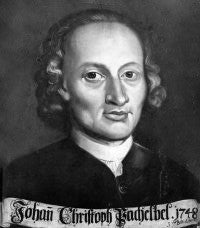Learn About the German Composer, Johann Pachelbel's Works and Life
Johann Pachelbel: Overview
- Born: September 1, 1653 - Nuremberg, Germany
- Died: March 3, 1706 - Nuremberg, Germany
- Historical Period: Baroque
- Musical Media: chamber music, keyboard, choral.

Johann Pachelbel: The Baroque Stalwart
Very early on, like many famous composers, he began to show talent in the musical arts. His education began under Heinrich Schwemmer and continued under George Kaspar Wecker. Under Wecker, he learned both the art of musical composition and to play the organ. Apart from this, Pachelbel was educated at St. Lorenz High School. He later entered Universität Altdorf in 1669, as an organist at the Church of Saint Lorenz.
Pachelbel also learned from Kaspar Prentz. Prentz was responsible for passing on to his student the knowledge of the then contemporary Italian music. Pachelbel moved to Vienna in the year 1673 and became an assistant organist at St. Stephen's Cathedral. Following another four years, he was appointed as a court organist in Eisenach, Bach’s eventual birthplace. This would lead to him becoming really intimate with J. S. Bach and his family and would tutor both Johann Sebastian Bach and his uncle, Johann Christoph Bach. The year 1678, after just one-year stay at Eisenach, saw the composer leave for Erfurt. There, he became an organist at the Predigerkirche.
In a comparatively brief lifetime of fifty-two years, he became responsible for the ascent of the south German organ music to new heights. The shift to Vienna, the then cultural capital of Europe allowed his innate talents to start manifesting in a strong manner. Apart from his experiences at Stephansdom, Eisenach, and at the Predigerkirche (Erfurt), he also performed as a court organist at Stuttgart, was appointed as an organist at Gotha, and ultimately spent his last years as a church organist at his birthplace Nuremberg at the St. Sebalduskirche in Nürnberg.
Johann Pachelbel is world famous for the composition of his chorale preludes along with the Lutheran chorale organ, where he introduced a number of techniques for variation. A staunch follower of Lutheranism, his stay in Vienna brought him into contact with the musical style of the composers Frohberger and Frescobaldi. This was responsible for contributing to his inspiration behind his chorale preludes, which were considered the most important, and popular Protestant melodies of 17th century in Northern Germany. Another very popular example of his work is the Canon in D Major. This was written with three violins, subsequently accompanied by a continuous repetitive theme bass line which is called “continuo”.
Pachelbel’s first wife was Barbara Gabler, whom he married in 1681. They had a son together. The year 1683 brought great suffering to the eminent composer when the plague killed both his wife and infant son. This is known to have possibly inspired his first major work, Musicalische Sterbens-Gedancken. In 1684 Pachelbel married Judith Drommer, his second wife, and had seven children with her. One of Pachelbel’s children was the popular composer and harpsichordist Wilhelm Hieronymus Pachelberg.
In 1690, Pachelbel accepted his appointment as a court organist at Stuttgart where he was patronized by Duchess Magdalena Sibylla. His career here was cut short when the Nine Years' War broke out between French emperor Louis XIV, and the coalition between Austria and the Holy Roman Empire. Pachelbel, after fleeing Stuttgart, presented to the world his first ceremonial music, Acht Chorale zum Praeambulieren, in the year 1693. This is the only ceremonial music he wrote.
The year 1699 was when Pachelbel published his famous six arias, Hexachordum Apollinis, for the organ or the harpsichord instruments. This is widely considered as one of the composer’s greatest works. Musicalische Ergötzung, was next published sometime around the turn of the 17th century and is a mix of chamber music, consisting of six suites for two violins and the basso continuo. Additionally, he is also identified as the writer of Chaconne in F minor, and Toccata in E minor.
Johann Pachelbel is best known for his liturgical and secular music. His compositions were wrought with rich instrumentation but were not as virtuosic as some other composers. He was an important figure in European musical culture in the Baroque era and paved the way for a number of other composers.
Reference Links:
- Johann Pachelbel on All Music
- Johann Pachelbel on The Famous People
- Johann Pachelbel on Britannica
- Johann Pachelbel on en.wikipedia.org
- Essential Dictionary of Composers by Alfred Publishing
Related piano music sheet:
- Canon in D: Pick your level - Piano sheet music
- Baroque Music: Piano sheet music at multi-levels
- Classical music: Piano sheet music at multi-levels
- Classical Piano and Keyboard music: Piano sheet music at multi-levels
- Music for Wedding: Piano sheet music at multi-levels
- Music from orchestral pieces: Piano solo sheet music at multi-levels
- Music for events: Piano sheet music at multi-levels
- Winter holiday and Christmas: Piano sheet music at multi-levels
- Pachelbel's music: Piano sheet music at multi-levels
- J.S. Bach's pieces: Piano sheet music at multi-levels
